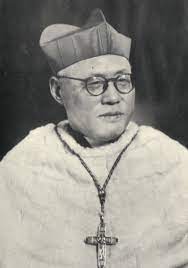T'ien Keng-hsin (24 October 1890-24 July 1967), the first Chinese to become a cardinal of the Roman Catholic Church.
The second son in a family of five children, T'ien Keng-hsin was born in Changch'iuchen, in the Yangku district of Shantung. His native place was a prosperous commercial center which was known for its uncommonly large variety of temples and shrines. Little is known about T'ien's mother except that her maiden name was Yang and that she came from Kochiachuang. His father, T'ien K'o-liang, the son of a prosperous merchant, was a shengyuan, a teaching scholar, and a poet. He supervised T'ien Keng-hsin's early training in the Chinese classics.
In 1896 T'ien K'o-liang began teaching Chinese at the Po-li-chuang Minor Seminary, a training center supported by Chang Ch'iu-chen's small Roman Catholic community. He was baptized in 1898, a year before his death. In 1901, at the age of 11, T'ien Keng-hsin was baptized, at which time he took the name of Thomas. The rest of the family converted to Roman Catholicism in later years. Beginning in 1904 T'ien studied in local Catholic seminaries for 12 years. He later characterized this educational experience as labored and considerably hampered by inept teaching and inadequate textbooks. Moreover, at its conclusion his ordination into the priesthood almost was sacrificed to the vagaries of illness and inner doubt. When tuberculosis caused him to be absent during the last critical months of his training, an unsympathetic bishop—possibly interpreting these lapses as signs of indecision as much as illness—threatened to deny him ordination. However, he finally entered the priesthood in June 1918.
From 1919 to 1929 Father T'ien served in seven different districts of the Shantung diocese. Local problems were compounded by dilemmas arising as a result of the First World War. At one point, all German priests were threatened with expulsion from Shantung and were assembled at a transfer center for evacuation, only to be returned to their posts at the urging of Chinese priests and parishioners. Foreign national interests were reflected in conflicts between French and German orders. Moreover, some foreign priests in Shantung tended to be contemptuous of Chinese priests. In two districts Father T'ien founded and administered schools. By appealing to Catholics in Shanghai, Hong Kong, and Southeast Asia, he raised about China Si 0,000, which enabled him to establish many training classes, to provide needy students with room and board, and to organize a variety of religious programs and organizations.
In March 1 929 Father T'ien joined the Society of the Divine Word. After two years of special study and training, he took the final vows on 7 February 1931. Upon his return to pastoral work in August 1932, he was assigned to a missio dependens comprised of Yangku, Shouchang, Ch'aoch'eng, Kuanhsien, and Fanhsien. It was designated an apostolic prefecture on 14 December 1932, and Father T'ien was appointed the apostolic prefect on 24 February 1933.
Father T'ien made his first journey outside China in February 1937, when he participated in the International Eucharistic Congress in Manila. The occasion for his second trip, in 1939, was a summons to be blessed personally by Pope Pius XII on the occasion of Father T'ien's appointment by the Curia Romana as apostolic vicar of Yangku. The Sino-Japanese war did not deter Father T'ien. He made his way through the Japanese lines to Shanghai and boarded a German liner bound for Europe, only to be turned back in mid-journey when war came to Europe. By changing ships, however, he finally reached Italy and the Vatican. He was consecrated a bishop by Pope Pius XII on 29 October 1939. After his return to China and three years of effective evangelism in Yangku, Bishop T'ien was appointed apostolic vicar of Tsingtao. On 24 December 1945 Pope Pius XII announced the appointment of Bishop T'ien to the college of cardinals, and on 18 February 1946 he became the first East Asian to be enthroned as a cardinal. China was designated a hierarchy of 20 sees on 11 April 1945, and Thomas Cardinal T'ien was named archbishop of Peiping.
Upon assuming his new duties on 29 June 1946, Cardinal T'ien promptly turned his attention to education. He urged young priests to undertake a period of university study and transformed a department at Fu-jen (Catholic) University in Peiping into St. Thomas College of Philosophy. He arranged for the schooling of young Catholic refugees, who swarmed into Peiping as the Communists advanced in north China. In the autumn of 1947 he founded the Keng-hsin Middle School, which was in fact a minor seminary. To improve the production and dissemination of Catholic literature, he established the Institutum St. Thomas as a publishing center and founded the Catholic Broadcasting Association. When an eye ailment forced him to seek medical treatment in Shanghai, Cardinal T'ien took what proved to be final leave of Peiping in June 1948. He went to the United States in the spring of 1949 and underwent medical treatment in Chicago. Before leaving China he was instrumental in sending ten young priests and more than twenty seminarians abroad to continue their studies.
Throughout the 1950's Cardinal T'ien lived in Chicago. In 1950 he made a trip to Rome for the issuing of the papal bull Munificentissemus Deus, which defined the dogma of the Assumption of the Virgin Mary. At the urging of the National Government in Taiwan, he paid a visit to Taiwan in September-November 1957. The following year, he took part in the papal elections. In December 1959 Pope John XXIII appointed him apostolic administrator of the Archdiocese of Taipei. Cardinal T'ien arrived in Taiwan in March 1960 to assume his new duties.
Cardinal T'ien made his last trip to Rome in 1962, when he participated in the Second Vatican Council and in the election of Pope Paul VI. On 24 July 1967 he died at St. Martin de Porres Hospital in Chiayi, Taiwan, at the age of 76.

田耕莘
教名:多玛斯
田耕莘(1890.10.24—1967.7.24),罗马天主教红衣主教中的第一个中国人。
田耕莘是全家五个孩子中的第二个儿子,生在山东阳谷县张秋镇,家乡是一个繁华的商业中心,该地不同异常地拥有各种寺庙和神坛,因而知名,母亲姓杨,是高家庄人,其他情况不详。父亲田开良,是一个有钱的商人之子,秀才、教师、诗人。田耕莘在他父亲督促下学习中国古籍。
1896年,他父亲在坡里庄小修道院教中文,这是张秋镇天主教会办的。他于1898年临死前一年,受洗入教。1901年,田耕莘十一岁时受洗,取教名多玛斯,他全家的其他成员在以后年代里也都入了教。1904年起,田在本地修道院学习十二年。他后来提到这一段受教育的经历说,由于教学方法不当和缺乏教材,学习很艰苦而且常常中断。此外,他还差一点因为身体有病以及内心疑惑引起的遐想而丢掉了自己的神职。他在决定性的最后几个月受训期间因患肺病而缺席。有一个暴戾的主教认为,他的缺席不只是因为病,而且是由于内心犹豫所致,竟以不授予神职威胁他。但是他最后还是在1918年6月当上了神父。
1919年到1929年,田耕莘神父在山东教区七个地方传教,当地的问题因第一次世界大战引起的困境而更形复杂。德国教士一度面临被逐出山东的威胁,并已集中待命撤走,仅因中国教士和教民的呼吁而得以返回各自的岗位。但是德法两国的利害冲突也反映在宗教界。此外,山东的外国教士惯于轻视中国教士。田神父在两个县里创办和经管学校,他向上海、香港、东南亚的天主教会募到一万元基金,使他能建立许多宗教训练班,供给学生所需的食宿,组织各种宗教活动和团契。
1929年3月,田神父加入圣言会,经过两年特殊训练和研究后于1931年2月7日立誓。1932年8月他到阳谷、寿张、朝城、观城、范县等县组成的“独立教区”任职,同年12月14日该教区改为“阳谷监牧区”,次年2月田神父被任命为宗座监牧。
1937年2月,田神父首次出国,参加在马尼拉举行的国际圣餐大会。1939年第二次出国,是因罗马教廷任命他为主教衔阳谷宗座代牧而召他去接受教皇庇护十二世“祝圣”(即亲自祝福)。中日战争并未能阻挡住田的活动,他通过日本防线到上海,乘德国邮船去欧洲,中途因欧洲战争爆发而被迫折回。他改乘别的船只终于到了意大利和梵蒂冈。1939年10月29日由教皇任命为主教。他回国后又在阳谷进行了三年有成效的传教,于是被任命为青岛主教。1945年12月24日,教皇把田列入主教院,1946年2月18日,他成为东亚的第一个枢机主教。1945年4月11日罗马教廷宣布中国全国划为二十个教区,任命田耕莘为北平总主教。
1946年6月29日田任新职后,立即将注意力转向教育,他敦促青年神父进大学学习一个时期,并把辅仁大学的一个系改为圣多玛哲学院,他又收留青年天主教徒,安排他们进了学校,当共产党入在华北推进的时候,他们进入了北平。1947年秋,他设立了耕莘中学,这事实上是一个小修道院。为了改进天主教书籍的印刷和散发,他又创办出版中心圣多玛编译馆,还成立了天主教广播协会。1948年6月,田因眼疾去上海治疗,这是他最后一次离开北平。1949年春他去美国芝加哥治病,离开中国前他还致力于派遣十名青年教士、二十多名修道士出国深造。
在五十年代,田住在芝加哥。1950年为发布教皇训令事去罗马,这个训令论述了有关圣母升天的教义。1957年9月到11月,田应国民政府之请去台湾访问。翌年,他参加了选举教皇的活动。1959年12月教皇若望二十三世任命田为台北总主教。1960年3月,他到台湾就任新职。
1962年,田最后一次到罗马,参加天主教第二次大公会议和新教皇保罗六世的选举。1967年7月24日,他死在台湾嘉义圣马丁医院。